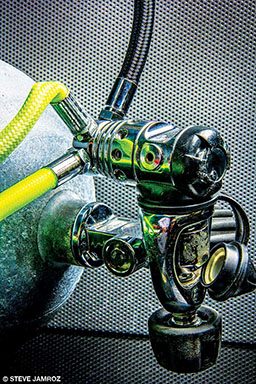An unexpected outcome
Alert Diver has published two articles on braided hose degeneration (Winter 2017, Summer 2017) that explain the issue of inappropriate lining material, but the following case proved to be very interesting. We urge you to read the two previous articles because they will provide important background information.
My cave-diving teammate and I were starting a dive in the basin at Madison Blue Spring State Park in Lee, Florida, on Nov. 4, 2019. We were diving a sidemount configuration with two 120-cubic-foot (12-liter) steel cylinders. I noted that my BC inflated more slowly than usual and that my inflator hose seemed soft to the touch, but I could breathe normally. During our predive safety drill at 25 feet before entering the cave system, I was inhaling from my left-hand cylinder and got a mouthful of debris. Thinking it was sand, I switched to my right-hand cylinder and regulator. When that regulator was difficult to breathe through, we surfaced to try to correct the problem.
— Ken Anderson
I took the regulator off the cylinder and opened the second stage, where I found a significant number of plastic particles impacted into the second stage’s inlet line. Suspecting that the low-pressure hose had failed, I made a swap and cleaned the debris out of the inlet. After another safety check, we proceeded into the cave for about 30 minutes before my breathing became difficult. As we swam along the return leg, I managed the situation by changing back and forth between tanks and did not need to buddy breathe on the exit. Breathing was progressively easier as we ascended, and we did our decompression stop at 20 feet before completing the dive.
Checking both second-stage inlets after the dive, I again found white plastic debris, even in the left-hand regulator that I had cleaned and changed hoses on before the dive. I was able to manage the dive with no ill effects but stopped using those hoses and regulators. Having read about hose degradation in Alert Diver, I contacted DAN® to report my incident and ask for help understanding what had happened. I spoke with their technical expert, who began investigating the cause of my equipment failure.

During our investigation we discovered that while the inflator hose had deteriorated dramatically, the two breathing hoses were still in pristine condition. The inflator hose was of a suspect origin; the two breathing hoses were from a reputable producer.
Combined with additional information obtained from an experienced regulator service technician in Cozumel and a test performed at DAN, we easily managed to get the crystals of degraded hose liner to move from the inflator hose to the breathing hose by simple mechanical agitation and gravity.
Some first-stage scuba regulators have a shared low-pressure hub, meaning that an inflator hose, the primary and secondary breathing regulator hoses and perhaps even a drysuit whip could become contaminated with debris from any single source.
We also realized that purging the second-stage regulator to release the pressure from all the hoses before disassembling dive gear causes gas in the other hoses to move backward toward the first-stage regulator. The gas could carry debris from any of the other low-pressure hoses with it and possibly through the first-stage regulator into the hose being used to vent the system.
Performing regular maintenance, checking your hoses and noting any difficulty in breathing or inflation during your predive check should prevent this situation from becoming an underwater incident. If your regulator has a shared low-pressure hub, using different types of hoses will not guarantee that this situation will not occur.
Please note that in the photos shown in this article, the failed hoses do not represent products supplied by the regulator manufacturer. Most regulator manufacturers supply their assemblies with carefully selected, high quality hoses. It is the practice of replacing these or fitting additional hoses with after-market products not endorsed by the manufacturers that can lead to these failures. Divers should select any additions to their dive equipment with care.
© Alert Diver — Q2 2020